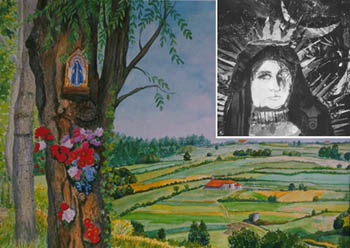![[MetroActive Arts]](/gifs/art468.gif)
[ Arts Index | Santa Cruz | MetroActive Central | Archives ]
Mary Mary, Quite Contrary
'Images of the Virgin' showcases a collection of mad, mirthful Madonnas
By Ruth Paget
THE NINTH annual "Images of the Virgin" exhibit at Galería Tonantzin challenges visitors to rethink traditional takes on female spirituality. The San Juan Bautista show traces the history of the Madonna in art and successfully taps into both the European/North American and Mexican versions of the mother of all mothers.
The Byzantine Church was the first to permit Marian images, and these fifth century works of Mary holding Jesus were lively and actually were lifted from the Egyptian tradition, specifically, depictions of the goddess Isis holding her son Horus.
As the Byzantine Empire expanded into the Balkan Peninsula and crossed the Adriatic to Italy in the seventh century, Mary the art object became in the process the passive, sad, dependent woman with whom present-day Judeo-Christian are familiar.
The first piece to catch my eye at Tonantzin was Lee Taiz' watercolor "On the Road to Altamira," which captures the depth of European Madonna devotion. Red, white, blue and purple flowers climb a trunk of a tree in the left foreground that houses a triangular yellow shrine with a blue Mary inside. The painting's green fields roll past a stone church and red-tile-roof house that resemble those in many areas of northwest Spain where roadside shrines dot the crossroads. I have driven past many such shrines with believers who make the sign of the cross as they pass, forming a contemporary link between Mary and the countryside.
Europe shares the black Madonna phenomenon with Mexico. While authorities attribute their color to candle smoke or divine intervention, the worship of these holy icons still inspires pilgrimages and miraculous cures. That black is associated with night, the moon and soil--all feminine attributes in pre-Christian culture--may explain why fair-complected believers worship Madonna negra.
THE BLACK Madonna of the Americas is the Virgin of Guadalupe, who occupies the top half of Allyson Rickard's mixed-media collage, "Serpent Rising." The delicate Virgin--bending her head, her hands held in prayer--is surrounded by a blue mantle decorated with stars and a golden aureole. Under this sacrosanct image, Rickard has placed a photo of the skull-head Aztec goddess Coatlicue, whose breasts sag like daggers and whose skirt writhes with snakes. She also sports a necklace comprised of human hearts and hands. An uncoiling snake rises next to her. On the right is Coatlicue's headless daughter Coyolxauhqui, whose head was thrown into the sky to become the moon. Both of these strong muscular Aztec goddesses represent alternative ideal visions of how Chicana artists view themselves.
The moon associated with Coyolxauhqui also shows up in another collage by Sylvia Betts, "Xochitl." This Madonna on black paper and fabric presents a crescent moon running from one side of the collage to the other. The moon's supposed effect on women has made it a common symbol of Aztec goddesses. The image links lunar and menstrual cycles and explains why women are venerated as the living embodiment of the celestial and earthly rhythms of life.
Adding "maintain cosmic harmony" to my worry list, I laughed when I came upon Terri Garland's "Our Lady of the Normal Cycle." The photograph features a porcelain Madonna standing in the center of the bottom tray of a dishwasher.
Cherie Stock's "La Riqueza de la Virgen (The Virgin's Riches)" unveils the feminine hoarding instinct. In the center of her mixed-media work is a picture of the Madonna surrounded by massed buttons and earrings that don't match.
ANOTHER FUN work is Fain Hancock's graffiti-inspired "Annunciation." Mary is written in pink in the center of the composition surrounded by "It's a boy!" stencilings and pear-shaped red uteruses that float on a gold background.
Susan Bartlett puts those too-good-to-throw-away Altoids Mints metal boxes to use in her "Our Lady of the Matc" montage. In the bottom half of a box that serves as the centerpiece for this work, Mary is painted inside a tartlette tray, holding a match like a scepter. On the other side are three sleeping Mary faces amid sequin-decorated skies.
Sheri Rice's mixed-media black fabric quilt "Glorified Women" uses a traditional art form to protest male-imposed female personae that are incorporated into the brain pans of women. A miniature True Confessions cover screams "My Baby Was Born of Sin."
All these joyful works show us that Mary has a sense of humor as well as lasting power. Think Barbie doll, Boticelli beauty, Victorian dowager; think the mother and the whore. Quiltmaker Rice fights such stereotypes, as do most of the women represented in the show, one that guarantees that a San Juan Bautista excursion will be worth both the trip there and the thought-provoking ride of anger and merriment you find upon arrival.
[ Santa Cruz | MetroActive Central | Archives ]
Copyright © Metro Publishing Inc. Maintained by Boulevards New Media.
![]()

Like a Virgin: Lee Taiz' watercolor 'On the Road to Altamira' and 'Xochitl/Flower' (inset) by Sylvia Betts are two of the Virgin Mary-inspired artworks at Galería Tonantzin.
Images of the Virgin runs through Jan. 14 at Galería Tonantzin, 115 3rd St., San Juan Bautista; 623.2783.
From the December 27, 2000-January 3, 2001 issue of Metro Santa Cruz.